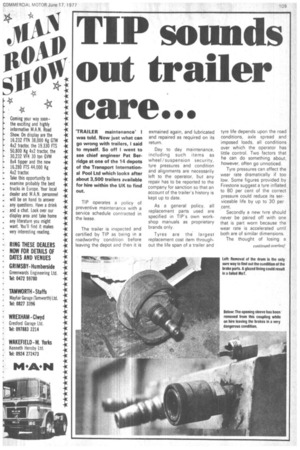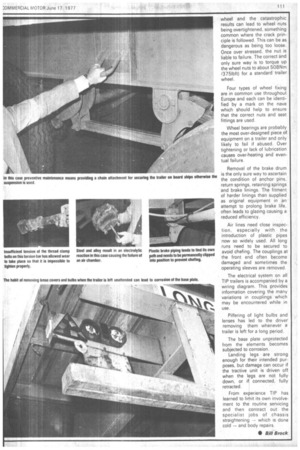TIP sounds out trailer care...
Page 123

Page 125

If you've noticed an error in this article please click here to report it so we can fix it.
'TRAILER maintenance' I was told. Now just what can go wrong with trailers, I said to myself. So off I went to see chief engineer Pat Berridge at one of the 14 depots of the Transport International Pool Ltd which looks after about 3,500 trailers available for hire within the UK to find out.
TIP operates a policy of preventive maintenance with a service schedule contracted in the lease.
The trailer is inspected and certified by TIP as being in a roadworthy 'condition before leaving the depot and then it is exmained again, and lubricated and repaired as required on its return.
Day to day maintenance, including such items as wheel/suspension security, tyre pressures and condition and alignments are necessarily left to the operator, but any repair has to be reported to the company for sanction so that an account of the trailer's history is kept up to date.
As a general policy, all replacement parts used are specified in TIP's own workshop manuals as proprietary brands only.
Tyres are the largest replacement cost item throughout the life span of a trailer and
tyre life depends upon the road conditions, axle spread and imposed loads, all conditions over which the operator has little control. Two factors that he can do something about, however, often go unnoticed.
Tyre pressures can affect the wear rate dramatically if too low. Some figured provided by Firestone suggest a tyre inflated to 80 per cent of the correct pressure could reduce its serviceable life by up to 30 per :cent.
Secondly a new tyre should never be paired off with one that is part worn because the wear rate is accelerated until both are of similar dimensions.
The thought of losing a wheel and the catastrophic results can lead to wheel nuts being overtightened, something common where the crack principle is followed. This can be as dangerous as being_ too loose. Once over stressed, the nut is liable to failure. The correct and only sure way is to torque up the wheel nuts to about 508Nm 1375Ibft) for a standard trailer wheel.
Pour types of wheel fixing are in common use throughout Europe and each can be identified by a mark on the nave which should help to ensure that the correct nuts and seat fittings are used.
Wheel bearings are probably the most over-designed piece of equipment on a trailer and only likely to fail if abused. Over tightening or lack of lubrication causes over-heating and eventual failure.
Removal of the brake drum is the only sure way to ascertain the condition of anchor pins, return springs, retaining springs and brake linings. The fitment of harder linings than supplied as original equipment in an attempt to prolong brake .life, often leads to glazing causing a reduced efficiency.
Air lines need close inspection, especially with the introduction of plastic pipes now so widely use.d. All long runs need to be secured to avoid chafing. The couplings at the front end often become damaged and sometimes the operating sleeves are removed.
The electrical system on all TIP trailers is accompanied by a wiring diagram. This provides information covering the many variations in couplings which may be encountered while in • use.
Pilfering of light bulbs and lenses has led to the driver removing them whenever a trailer is left for a long period.
The base plate unprotected from the elements becomes subjected to corrosion.
Landing legs are strong enough for their intended purposes, but damage can occur if the tractive unit is driven off when the legs are not fully down, or if connected, fully retracted.
From experience TIP has learned to limit its own involvement to the routine servicing and then contract out the specialist jobs of chassis straightening — which is done cold -and body repairs.
• Bill Brock












































































































































































